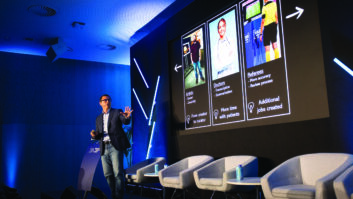Artificial intelligence (AI) is a broadly used term to define machines that can continue to learn and improve their algorithms without human input. Perhaps the most commonly recognised example is virtual assistant devices such as Alexa, which is now able to understand 90 per cent of the conversation around it. AI is even responsible for the computation happening behind the scenes within Salesforce, Facebook, Google, and other online platforms. In 2017, businesses spent $12.5 billion on AI systems, and analysts expect that number will grow by 54.4 per cent through 2020. That’s because new programming techniques, algorithms, and computational languages are allowing computers to cross new thresholds in self-learning and self-teaching, driving new innovations with untold potential, especially within enterprise collaboration.
Currently, AI will provide many automated benefits for collaboration. This includes AI assistants that can start meetings, mute microphones, reset the system when the conference concludes, and schedule future meetings.
Participants never have to touch a button for these tasks. This not only simplifies and streamlines the collaboration process, but it also eliminates the hassle of training participants on how to operate various devices and applications while allowing them to focus on their primary responsibilities and giving them time to brainstorm.
In addition, AI is making strides in improving audio conferencing quality. With new capabilities, audio processing technology can learn what audio data is unwanted in an audio stream, such as background noise, detect it when it occurs, and eliminate it from the conversation. This ensures a clear, accurate, and productive conference without distractions and disruptions.
As algorithms continue to be refined, AI-based audio and video technology will be able to further their ability to learn and understand the nuances of human language for improved voice-to-text applications. In meeting applications, headway is already being made in this area, allowing conferencing systems to identify speakers and their voices through voice imprint technology. Now the AI assistants in these systems can take notes and transcribe the conversation, eliminating the need for human-based services. Plus, it can deliver the transcription with vital information highlighted and create a list of action items for participants. This represents a valuable, more cost-efficient content stream for companies and improves productivity.
There are a lot of industry predictions about AI, some of which are more realistic than others. In the coming year it’s expected that more than 10 per cent of IT department’s customer service staff will be devoted to writing scripts for robots. These scripts will allow businesses to automate the more mundane parts of customer service, leaving AI machines, rather than humans, to handle simple tasks such as travel reservations, banking, and more. Another example is teaching how to connect a new user to a collaboration meeting with a computer and AI can help guide the user without human intervention.
In the future, AI will make it even easier to have meetings where every component is automated and participants never have to lift a finger to start, manage or end a meeting. Virtual reality will also be part of this development, providing participants with the capability to insert 3D objects such as products, spreadsheets, or even dynamic, real-time data into the meeting video stream and analyse them in new, deeper ways. The companies that are able to harness the power of machine learning data in order to create a more natural interaction with people over time and distance will ultimately create a richer, more collaborative experience.
We live in very complicated information structures. AI isn’t going to address every component of a meeting perfectly, but the tradeoff is an algorithm that gives users a fairly high calculation that, in most instances, a human couldn’t replicate each and every time. Currently, that means that companies can use the technology to address and improve their long-term IT and collaboration needs. When it comes to improving the user experience and opening up new business opportunities, the industry is only at the beginning of the imagination of what AI could accomplish.
Writtn by Phil Marechal, vice president, product management and business development, Yamaha UC







